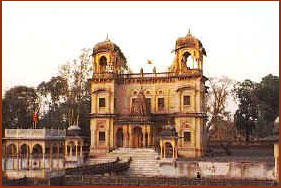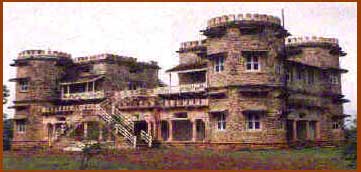|
Travelogues Madhav National Park, Shivpuri
|
|||||
We had been driving 1000 kms from Mumbai and it was the second day of our journey. Like this one, most of our holidays are unplanned. We had suddenly decided to travel towards Uttaranchal, in the North of the country, 2000 kms away. As a family we enjoy driving holidays, taking off for a couple of weeks in the car with no particular destination in mind; the journey itself becomes the destination.
If you want a family to get away from its daily routine and just bond, there is no better way than to seal everyone together in a car for 10 hours a day. No distractions of TV, computer, friends. You get what I mean? You either tear each other to bits or you bond. |
More on M.P. • An Overview • Shivpuri
Travelogues | ||||
It is the month of May and the weather is a scorcher. The weather bureau states that temperatures are 4 to 6 degrees above normal on our route. It's 45 degrees C in some places. I'm dog-tired and concentrate from sheer willpower. A cramp in my neck won't go away, my brain can't handle the traffic anymore and after driving for 10 hours non-stop, we need to rest. We had taken a break on the first day in Indore and now decide to stop over at Madhav National Park at Shivpuri. Two years ago I had driven to neighbouring Himachal Pradesh but had taken the route via Gujarat and Rajasthan. This time Gujarat is best avoided because of the riots that are taking place there. So we decide to drive through Madhya Pradesh. I am surprised to find that road conditions are fairly good by Indian standards, meaning that I am not driving over miles of potholed roads. One day the country will have international class highways with neat clean places to eat at and stop over en route and I will finally be really happy. At 3.30 in the afternoon we arrive at Shivpuri. The district derives its name from Lord Shiva and was earlier known as 'Sipri'. The district was ruled by the Kachhawaha Rajputs upto 1804 and then taken over by Scindia's.
There is a spectacular view of the Sakhya Sagar Lake from the boat club where we see some paddle boats for hire. I know that the lake is home to marsh crocodiles and marvel at the audacity of the merry makers who paddle in the waters. We notice that the Park offers some accommodation but it is primitive and the facilities are minimal.
While driving through the forest we see herds of chinkara, sambar and the ubiquitous langur. Ever so often, quail waddle across the road. We do not get to spot any leopard though there are reportedly 25 of them in the park. We do go across to an enclosure where there are two leopards and a tigress in captivity. At the lake we spot many varieties of avifauna. And then what looks like a rock in the water begins to move. Scales rise above the surface and we note that it is a marsh crocodile.
We hear about the summer palace of the Scindia's, which the brochures describe as "alluring, dressed in soft shades of rose-pink." However, we decide not to visit it as this once grand palace has been converted into a training center for the Intelligence Bureau and we do not want to risk a brush with surly officialdom in an otherwise pleasant holiday. We do go across to the chattris of Madhav Rao Scindia and his mother. Set among beautiful gardens and maintained by a private trust they are very well maintained. The people here are still deferential to the erstwhile rulers as can be seen in the respectful way they walk around the grounds. We are requested to take off our shoes at the entrance and as we walk along the gardens we note the distinct similarity with the Mughal gardens at Agra and Srinagar. The two chatris face each other across a water tank. It is ironical that the water tank, which must have once murmured to the sound of rippling water, is now dry. The entire area once belonged to these rulers to whom the chattris are dedicated and now they do not even have access to the water from their former lake. The architecture is a delightful fusion of Hindu and Islamic architectural styles, with their shikhara type spires and Rajput and Mughal pavilions. The retainer at one of the chatris is involved in trying to make the visitors keep their voices low in deference to the sanctity of the place. We engage him in conversation and he lovingly shows us around the place and regales us with stories of the erstwhile rulers whom he respects so much. Strange how time stands still long enough in homage through edifices and monuments.
|
|||||
Editor: Romola Butalia (c) India Travelogue. All rights reserved. |
|||||

 We know that the town itself does not have much to offer. Situated 114 km from Gwalior, it is the old summer capital of its erstwhile rulers, the Scindias. The main attractions in the town are the chhatris (cenotaphs) of the rulers and the Madhav National Park. We decide to check in at the MP State Tourism Dev. Corporation Tourist Village at Bhadaiya Kund and are delighted to find a well-maintained sprawling set-up with polite staff. We hire one of the cottages and promise them that we will be back for dinner and some chilled beer. We shower quickly and drive to the National Park since they will not permit entry after 5 pm. Despite the heat, summer is usually a good time to visit national parks. The forests dry out and there is very little green cover so it's easier to spot the animals. Entry for diesel vehicles has been prohibited in the park. I fortunately drive a petrol Zen. We reach the gates exactly at 5 pm, buy our tickets, hire a guide and are off to view wildlife.
We know that the town itself does not have much to offer. Situated 114 km from Gwalior, it is the old summer capital of its erstwhile rulers, the Scindias. The main attractions in the town are the chhatris (cenotaphs) of the rulers and the Madhav National Park. We decide to check in at the MP State Tourism Dev. Corporation Tourist Village at Bhadaiya Kund and are delighted to find a well-maintained sprawling set-up with polite staff. We hire one of the cottages and promise them that we will be back for dinner and some chilled beer. We shower quickly and drive to the National Park since they will not permit entry after 5 pm. Despite the heat, summer is usually a good time to visit national parks. The forests dry out and there is very little green cover so it's easier to spot the animals. Entry for diesel vehicles has been prohibited in the park. I fortunately drive a petrol Zen. We reach the gates exactly at 5 pm, buy our tickets, hire a guide and are off to view wildlife.
 These forests were once the hunting grounds of Mughal emperors and herds of elephants were captured by Emperor Akbar. Much later, it was a favourite ground for shikaris to hunt the tiger that roamed these plains.
These forests were once the hunting grounds of Mughal emperors and herds of elephants were captured by Emperor Akbar. Much later, it was a favourite ground for shikaris to hunt the tiger that roamed these plains.
 We drive over to the highest point in the park, the George Castle. This was built by Jiwaji Rao Scindia in 1911 and offers a spectacular view of the surroundings hills, rolling plains and lake. The guide informs us that the castle was constructed to fulfill George the Vth's desire to shoot a tiger. Belgian and Italian glass panels decorate the windowpanes. As it so happened he managed to shoot a tiger on the way itself and did not stop at the castle. It is evening and the sun is about to set and the changing colours of the sky reflect in the lake in myriad hues.
We drive over to the highest point in the park, the George Castle. This was built by Jiwaji Rao Scindia in 1911 and offers a spectacular view of the surroundings hills, rolling plains and lake. The guide informs us that the castle was constructed to fulfill George the Vth's desire to shoot a tiger. Belgian and Italian glass panels decorate the windowpanes. As it so happened he managed to shoot a tiger on the way itself and did not stop at the castle. It is evening and the sun is about to set and the changing colours of the sky reflect in the lake in myriad hues.